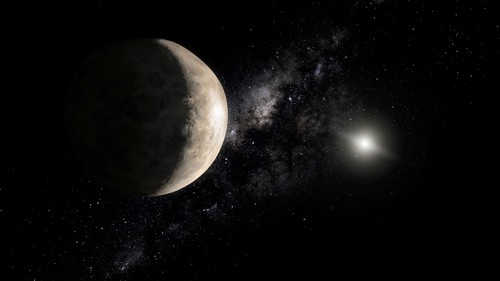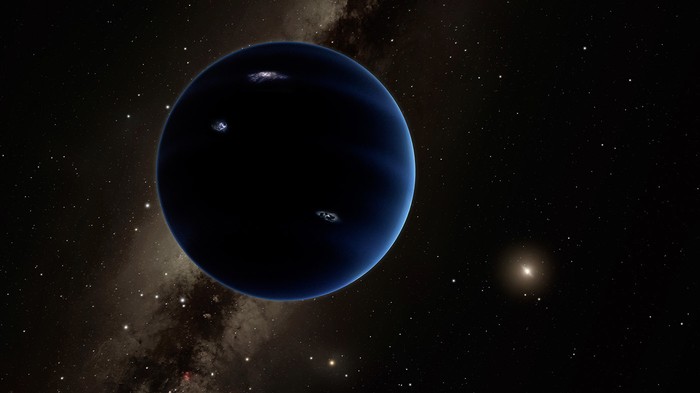Post by Admin on Sept 17, 2021 12:17:40 GMT
Objects at the Solar System’s Edge Are Being Influenced by Something Mysterious


The discovery of hundreds of new objects in the outer solar system confirms weird gravitational effects that could be caused by “Planet Nine.”

A dwarf planet in the outer solar system. Image: Stocktrek Images via Getty Images
Scientists have discovered hundreds of new objects in the outer solar system using an instrument designed to probe an unexplained source of energy in the universe. The results reveal new insights about the mysterious expanse beyond Neptune, including the possibility that a massive undiscovered planet may be lurking in these dark outer reaches.
A team led by Pedro Bernardinelli, a postdoctoral researcher at the University of Washington, scanned the outer solar system for six years with the Dark Energy Survey (DES), a Chile-based astronomy program whose primary objective is understanding dark energy, an unknown force that’s driving the accelerated expansion of the universe.
A team led by Pedro Bernardinelli, a postdoctoral researcher at the University of Washington, scanned the outer solar system for six years with the Dark Energy Survey (DES), a Chile-based astronomy program whose primary objective is understanding dark energy, an unknown force that’s driving the accelerated expansion of the universe.
The DES normally works on mind-boggling cosmic scales, but Bernardinelli and his team were able to shed light on enigmas that are much closer to home within our own solar system. The researchers have used the survey to discover a total of 815 trans-Neptunian objects (TNOs), which are minor bodies beyond Neptune, 416 of which are reported for the first time in a new paper published on the preprint server arXiv.
“Searching for TNOs in the DES images presents challenges since it was not optimized for this purpose,” the team notes in the study. “Despite this, the DES sample is comparable in number of objects to the largest predecessor TNO-targeted surveys” and has provided findings that “are relevant to more detailed hypotheses of the formation of the outer Solar System.”
The survey was especially adept at spotting “dynamically detached” objects and “extreme TNOs” located 150 times farther from the Sun than Earth. These objects have been the subject of much speculation in recent years, because it looks like something in the outer reaches of the solar system is gravitationally tugging at them, causing a clustering effect in their orbits.
One tantalizing explanation for this phenomenon is the existence of a huge planet, about five to ten times the mass of Earth, that is ensconced in the hidden depths of the solar system. This so-called “Planet Nine” would likely be around 400 times as far from the Sun as Earth and may take some 20,000 years to complete an orbit. Scientists have been searching for traces of this planet for years, but have yet to snag a direct detection.
“Searching for TNOs in the DES images presents challenges since it was not optimized for this purpose,” the team notes in the study. “Despite this, the DES sample is comparable in number of objects to the largest predecessor TNO-targeted surveys” and has provided findings that “are relevant to more detailed hypotheses of the formation of the outer Solar System.”
The survey was especially adept at spotting “dynamically detached” objects and “extreme TNOs” located 150 times farther from the Sun than Earth. These objects have been the subject of much speculation in recent years, because it looks like something in the outer reaches of the solar system is gravitationally tugging at them, causing a clustering effect in their orbits.
One tantalizing explanation for this phenomenon is the existence of a huge planet, about five to ten times the mass of Earth, that is ensconced in the hidden depths of the solar system. This so-called “Planet Nine” would likely be around 400 times as far from the Sun as Earth and may take some 20,000 years to complete an orbit. Scientists have been searching for traces of this planet for years, but have yet to snag a direct detection.
As a result, Planet Nine remains purely speculative and other hypotheses have been proposed to explain the clustering pattern seen with the extreme TNOs. It’s possible that the combined gravitational pull of many smaller objects is causing the effect, or that natural instabilities arise within this farflung population of bodies. One team has even suggested that a black hole, not a planet, might be the entity that is warping these extreme TNO orbits.

Tech
Mysterious 'Planet Nine' Might Actually Be a Gigantic Disk of Space Objects
Mysterious 'Planet Nine' Might Actually Be a Gigantic Disk of Space Objects
Bernardinelli’s team announced the discovery of nine new extreme TNOs in their study, in addition to seven others that DES had previously spotted. While the study does not support or refute the Planet Nine hypothesis, the inclusion of these new distant bodies will help scientists hone in on the possible causes of their anomalous orbits in future research.
The new study demonstrates that astronomical instruments, such as DES, can enable discoveries and advances that have nothing to do with their primary missions. Though the survey is attuned to studying the acceleration of the universe, it has also sped up our understanding of the most familiar place within this expanding cosmos: our own solar backyard.
The new study demonstrates that astronomical instruments, such as DES, can enable discoveries and advances that have nothing to do with their primary missions. Though the survey is attuned to studying the acceleration of the universe, it has also sped up our understanding of the most familiar place within this expanding cosmos: our own solar backyard.











